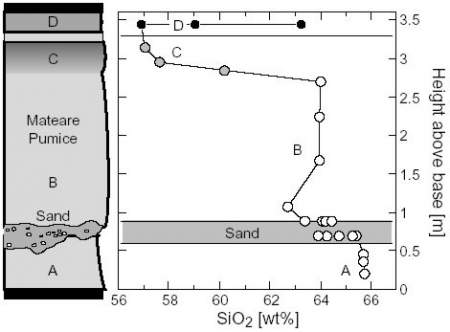 Web Content Anzeige Web Content Anzeige
Tsunami hazardsXiloa Tephra is capped by a bipartite sand layer. The lower, <15-cm-thick sand bed is well sorted and finely bedded beach sand containing reworked Xiloa pumice clasts. An erosional unconformity separates it from the upper sand layer, which is massive, of variable thickness (mostly 2-15 cm) and wavy surface, and locally fills up to 1.5-m-deep gullies where it has a chaotic, lensoid structure. The upper sand contains pumice clasts from the overlying zoned Mateare Pumice (Fig. 2). This sequence is observed in outcrops within 1 km distance from present lake shore. At an outcrop c. 3 km inland, no beach sand is found atop Xiloa Tephra. Here, a sand layer equivalent to the upper sand in near-shore exposures occurs within the Mateare Pumice deposit (Fig. 2). Primary Mateare pumice below the sand (A) has the most highly evolved composition, and there is a compositional gap in the chemical zonation between this lower pumice A and the base of the Mateare pumice B atop the sand layer. Mateare pumice clasts entrained in the sand at this and the near-shore outcrops have compositions falling into this gap. Hence the sand layer formed during the Mateare eruption, which vented from a location on or near Chiltepe peninsula that cannot be constrained more precisely due to lack of exposures. We interpret the massive, locally chaotic sand layer as a tsunami deposit. Tsunami flooding prevented deposition of Mateare pumice in near-shore areas during early stages of eruption, all pumice fallout being immediately entrained in the tsunami floods. Locations farther from shore were initially not affected but some time into the eruption an especially strong tsunami flooded at least 3 km inland to interupt pumice fallout deposition by emplacement of a sand layer. The remaining three quarters of the eruption apparently did not produce strong tsunamis, suggesting steady eruption conditions forming a massive, unbedded pumice fallout deposit succeded an initial phase of violent explosions generating the lowermost well-bedded pumice sequence and the tsunamis. This example from a relatively young (2000-6000 yrs BP) emphasizes the tsunami hazard associated with highly explosive eruptions around the two great lakes of Nicaragua (see Fig. 1a).
Fig. 2: Compositional zonation of the Mateare Pumice. The compositional gap between layers A and B is bridged by pumice clasts entrained in the intercalated tsunami sand. Note steep compositional gradient across layer C. Top layer D is a terminal phreatomagmatic deposit containing entrained clasts from earlier eruption stages. |
 Events Events
Kieler Wissenschaftler fühlen den 'Puls der Erde' Wie funktioniert die Recyclingmaschine der Erde?Nach elf Jahren endet der Kieler Sonderforschungsbereich 574 zu Subduktionszonen Final colloquium of SFB 574 Teilprojekt ÖffentlichkeitsarbeitMEERESFORSCHUNG FÜR MICH UND DICH |
|
©SFB574 // Wischhofstrasse 1-3 // D-24148 Kiel // T. +49 (0)431 600 1413 // elange [AT] geomar.de






